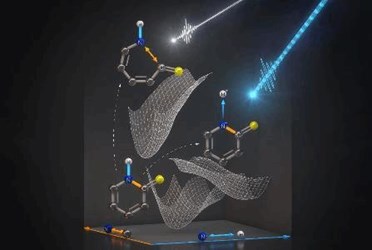Proton Transfer: Researchers Find Molecular Protective Mechanisms Against Light-Induced Damage

An international team of researchers from the Helmholtz Center Berlin (HZB), as well as from Sweden and the USA, has investigated a mechanism that protects biomolecules, such as the DNA, against damage by light. They observed how the energy of the incident photons is absorbed in the molecule without damaging important bonds of the biomolecule. The experiments were carried out at the free electron laser LCLS in California and at the synchrotron source BESSY II of the HZB in Berlin, where a very sensitive measuring method is available with the method of resonant inelastic X-ray scattering, RIXS.
Biomolecules such as the genetic DNA require protection mechanisms against energetic light. Otherwise, UV components from the sunlight would quickly break bonds and decompose molecules. The so-called proton transfer plays an important role. With it, a DNA molecule can emit the energy emitted via the light - a single proton (hydrogen nucleus) dissolves - and other chemical bonds are retained.
In order to investigate the process in detail, an international cooperation was conducted by Prof. Dr. Alexander Föhlisch, Head of the Institute at the Helmholtz Center Berlin, in California at the LCLS laser of the SLAC National Accelerator Laboratory and at the Berlin synchrotron source BESSY II of the HZB: They studied a relatively simple molecule, the 2-thiopyridone (2-TP). This molecule has properties similar to the building blocks of DNA and therefore serves as a model molecule in biotechnology.
The research group initially targeted the nitrogen atom in the molecule with very short x-ray pulses in the femtosecond range (10 -15 s). The results, which are now published in the Applied Chemistry Review, show in detail how the proton bound to the nitrogen atom is released after excitation with the light pulse.
"First we wanted to investigate these processes on a simple model system," says first author Sebastian Eckert, who writes his dissertation at the University of Potsdam and the Helmholtz Center Berlin at Alexander Föhlisch. "The model system 2-thiopyridone is suitable because the molecule is small Is enough to understand it and has only a single nitrogen atom. Only by comparison between the FEL measurements and experiments on the synchrotron BESSY II could the mechanism be unambiguously assigned. "The team had applied the method of so-called inelastic X-ray scattering, RIXS, to BESSY II for molecular changes around the nitrogen Which are associated with the rapid proton transfer and proceed extremely rapidly, within femtoseconds.
By combining the experiments with theoretical simulations, the reaction path could finally be worked out. These calculations were carried out by the doctoral student Jesper Norell and Prof. Dr. Michael Odelius of the University of Stockholm within the framework of the Helmholtz Virtual Institute "Dynamic Pathways in Multidimensional Landscapes".
Source: Helmholtz Center Berlin (HZB)
